
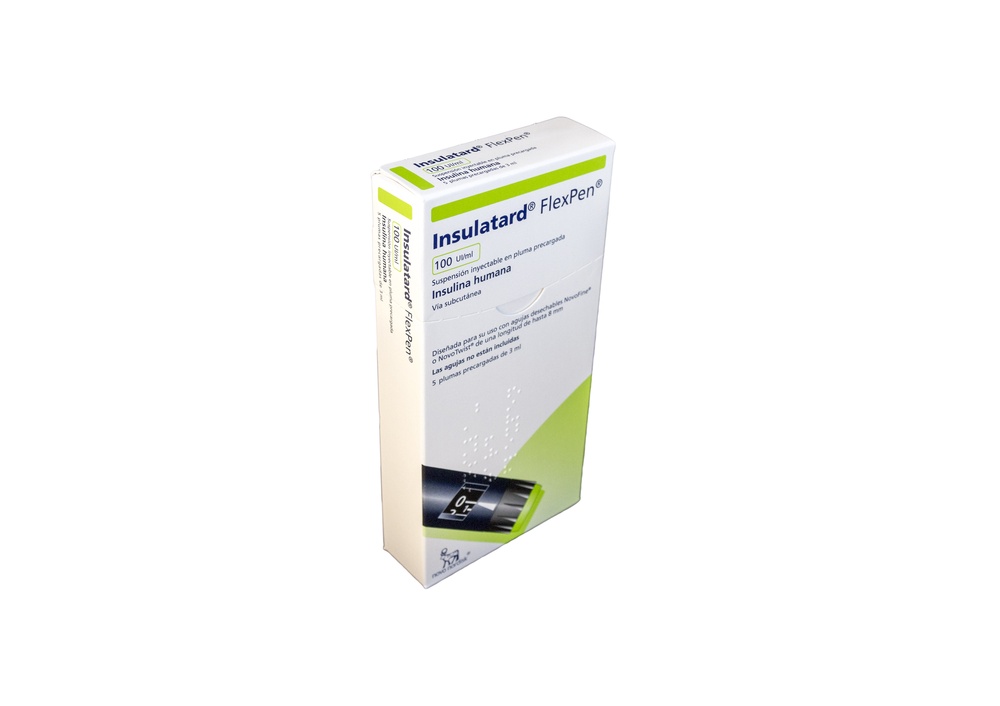
INSULATARD FLEXPEN 100 IU/ml INJECTABLE SUSPENSION IN PRE-FILLED PEN


How to use INSULATARD FLEXPEN 100 IU/ml INJECTABLE SUSPENSION IN PRE-FILLED PEN
Introduction
Package Leaflet: Information for the user
Insulatard FlexPen 100UI/ml (International Units/ml) injectable suspension in a pre-filled pen
Human insulin
Read all of this leaflet carefully before you start using this medicine because it contains important information for you.
- Keep this leaflet, you may need to read it again.
- If you have any further questions, ask your doctor, pharmacist, or nurse.
- This medicine has been prescribed for you only. Do not pass it on to others. It may harm them, even if their symptoms are the same as yours.
- If you get any side effects, talk to your doctor, pharmacist, or nurse. This includes any possible side effects not listed in this leaflet. See section 4.
Contents of the pack
- What is Insulatard and what is it used for
- What you need to know before you use Insulatard
- How to use Insulatard
- Possible side effects
- Storing Insulatard
- Contents of the pack and other information
1. What is Insulatard and what is it used for
Insulatard is a human insulin with a gradual onset of action and long duration.
Insulatard is used to reduce high blood sugar levels in patients with diabetes mellitus (diabetes). Diabetes is a disease in which your body does not produce enough insulin to control your blood sugar levels. Treatment with Insulatard helps to prevent complications of diabetes.
Insulatard starts to lower your blood sugar level about 1 hour and a half after injection, and the effect lasts for approximately 24 hours. Insulatard is usually given in combination with fast-acting insulin preparations.
2. What you need to know before you use Insulatard
Do not use Insulatard
- If you are allergic to human insulin or any of the other ingredients of this medicine, see section 6.
- If you suspect you are starting to experience hypoglycaemia (low blood sugar), see Summary of serious and very common side effects in section 4.
- In insulin infusion pumps.
- If the FlexPen has been dropped, damaged, or broken.
- If it has not been stored correctly or if it has been frozen, see section 5.
- If the resuspended insulin does not have a uniformly white and cloudy appearance.
If any of these conditions apply, do not use Insulatard. Consult your doctor, pharmacist, or nurse.
Before using Insulatard
?Check the label to ensure it is the correct type of insulin.
? Always use a new needle for each injection to avoid contamination.
? Needles and Insulatard FlexPen must not be shared.
? Insulatard FlexPen is only intended for subcutaneous injection. Consult your doctor if you need to inject insulin by another method.
Warnings and precautions
Certain conditions and activities may affect your insulin needs. Consult your doctor:
- If you have kidney, liver, adrenal, pituitary, or thyroid problems.
- If you do more physical exercise than usual or if you want to change your usual diet, as this may affect your blood sugar level.
- If you are ill, you should continue to use insulin and consult your doctor.
- If you are going to travel abroad, traveling across different time zones may affect your insulin requirements and the timing of your injections.
Changes in the skin at the injection site
You should rotate the injection site to help avoid changes in the fatty tissue, such as thickening of the skin, shrinking of the skin, or lumps under the skin. Insulin may not work well if injected into a lumpy, shrunk, or thickened area (see section 3). Inform your doctor if you notice any changes in the injection site area. Inform your doctor if you are currently injecting into these affected areas before starting to inject into a different area. Your doctor may advise you to check your blood sugar levels more closely and adjust your insulin dose or the dose of your other antidiabetic medications.
Other medicines and Insulatard
Tell your doctor, pharmacist, or nurse if you are taking, have recently taken, or might take any other medicines.
Some medicines affect your blood sugar level, and this may mean you need to adjust your insulin dose. The following are the most common medicines that may affect your insulin treatment.
Your blood sugar level may decrease (hypoglycaemia) if you take:
- Other medicines for the treatment of diabetes
- Monoamine oxidase inhibitors (MAOIs) (used to treat depression)
- Beta-blockers (used to treat high blood pressure)
- Angiotensin-converting enzyme (ACE) inhibitors (used to treat certain heart conditions or high blood pressure)
- Salicylates (used to relieve pain and lower fever)
- Anabolic steroids (such as testosterone)
- Sulphonamides (used to treat infections).
Your blood sugar level may increase (hyperglycaemia) if you take:
- Oral contraceptives (birth control pills)
- Thiazides (used to treat high blood pressure or excessive fluid retention)
- Glucocorticoids (such as cortisone, used to treat inflammation)
- Thyroid hormone (used to treat thyroid disorders)
- Sympathomimetics (such as adrenaline, salbutamol, or terbutaline, used to treat asthma)
- Growth hormone (a medicine that stimulates bone and somatic growth and has a significant influence on the body's metabolic processes)
- Danazol (a medicine that acts on ovulation).
Octreotide and lanreotide (used to treat acromegaly, a rare hormonal disorder that usually occurs in middle-aged adults, caused by an excess production of growth hormone in the pituitary gland) may increase or decrease your blood sugar level.
Beta-blockers (used to treat high blood pressure) may weaken or completely suppress the early warning symptoms that help you recognize a low blood sugar level.
Pioglitazone (tablets used to treat type 2 diabetes)
Some patients with type 2 diabetes of long duration and pre-existing heart disease or stroke who were treated with pioglitazone and insulin developed heart failure. Inform your doctor as soon as possible if you have signs of heart failure, such as unusual shortness of breath, rapid weight gain, or localized swelling (edema).
If you have taken any of the medicines on this list, inform your doctor, pharmacist, or nurse.
Using Insulatard with alcohol
? If you drink alcohol, your insulin needs may change, as your blood sugar level may increase or decrease. You are advised to keep a close check.
Pregnancy and breast-feeding
? If you are pregnant, think you may be pregnant, or plan to become pregnant, consult your doctor before using this medicine. Insulatard can be used during pregnancy. You may need to adjust your insulin dose during pregnancy and after delivery. Keeping a close check on your diabetes, especially to prevent hypoglycaemia, is important for the health of your baby.
? There are no restrictions on the use of Insulatard during breast-feeding.
Consult your doctor, pharmacist, or nurse before using this medicine during pregnancy or breast-feeding.
Driving and using machines
? Ask your doctor whether you can drive a vehicle or use machines:
- If you often have episodes of hypoglycaemia.
- If you find it hard to recognize the symptoms of hypoglycaemia.
If your blood sugar level is too high or too low, it may affect your concentration and reaction ability, and therefore also your ability to drive or use machines. Bear in mind that you could endanger yourself or others.
Insulatard contains sodium
Insulatard contains less than 1 mmol of sodium (23 mg) per dose; this is essentially “sodium-free”.
3. How to use Insulatard
Dose and when to use the insulin
Follow exactly the instructions for administration of this medicine and the dose indicated by your doctor. If you are in doubt, consult your doctor, pharmacist, or nurse again.
Do not change your insulin unless your doctor tells you to. If your doctor switches you from one type or brand of insulin to another, you may need to adjust your dose.
Use in children and adolescents
Insulatard can be used in children and adolescents.
Use in special patient groups
If you have kidney or liver failure or if you are over 65 years old, you should check your blood sugar level more often and discuss possible dose adjustments with your doctor.
How and where to inject the insulin
Insulatard is administered by subcutaneous injection (under the skin). It should never be injected directly into a vein (intravenous injection) or muscle (intramuscular injection). Insulatard FlexPen is only intended for subcutaneous injection. Consult your doctor if you need to inject insulin by another method.
For each injection, change the injection site within the area of skin you use. This may reduce the risk of developing lumps or hollows in the skin, see section 4. The best areas for injection are: the front of the waist (abdomen), the buttocks, the front of the thighs, or the upper arms. The effect of the insulin will be quicker if you inject into the abdomen. You should measure your blood sugar level regularly.
How to handle Insulatard FlexPen
Insulatard FlexPen is a pre-filled disposable pen that contains human isophane insulin (NPH).
Read carefully the Instructions for using Insulatard FlexPen included in this leaflet. You should use the pen as described in the Instructions for using Insulatard FlexPen.
Always make sure you use the correct pen before injecting your insulin.
If you use more insulin than you should
If you use too much insulin, your blood sugar level will be too low (hypoglycaemia). See Summary of serious and very common side effects in section 4.
If you forget to use your insulin
If you forget to use your insulin, your blood sugar level may become too high (hyperglycaemia). See Effects of diabetes in section 4.
If you stop using insulin
Do not stop using your insulin without talking to your doctor first. Stopping your insulin may lead to very high blood sugar levels (severe hyperglycaemia) and ketoacidosis. See Effects of diabetes in section 4.
If you have any other questions about the use of this medicine, ask your doctor, pharmacist, or nurse.
4. Possible side effects
Like all medicines, this medicine can cause side effects, although not everybody gets them.
Summary of serious and very common side effects
Low blood sugar (hypoglycaemia)is a very common side effect. It may affect more than 1 in 10 people.
Your blood sugar level may fall if:
- You inject too much insulin.
- You eat too little or skip a meal.
- You do more exercise than usual.
- You drink alcohol, see Using Insulatard with alcohol in section 2.
Signs of a low blood sugar level: cold sweat, cool pale skin, headache, fast heartbeat, feeling sick, excessive hunger, temporary visual disturbances, drowsiness, unusual tiredness or weakness, nervousness or tremor, anxiety, confusion, difficulty concentrating.
A severe low blood sugar level can lead to loss of consciousness. If not treated, it may cause brain damage (temporary or permanent) and even death. You may regain consciousness more quickly after an injection of glucagon given by someone who knows how to do it. If you are given glucagon, you will also need to eat glucose or a sugary snack as soon as you regain consciousness. If you do not respond to glucagon treatment, you must seek medical help immediately.
What to do if you experience low blood sugar:
? If you experience low blood sugar, take glucose tablets or another sugary product (such as sweets, biscuits, or fruit juice). If possible, measure your blood sugar level and rest. Always carry glucose tablets or sugary products with you in case you need them.
? Once the symptoms of low blood sugar have disappeared, or when your blood sugar level has stabilized, continue with your insulin treatment as usual.
? If your blood sugar level is so low that you lose consciousness, if you need an injection of glucagon, or if you have had many episodes of low blood sugar, talk to your doctor. You may need to adjust your insulin dose or the frequency of your injections, your diet, or your exercise.
Tell the people close to you that you have diabetes and what the consequences may be, such as the risk of losing consciousness (due to a low blood sugar level). Make sure they know what to do in such cases. If you lose consciousness, they should turn you on your side and seek medical help immediately. They should not give you anything to eat or drink, as you might choke.
A severe allergic reactionto Insulatard or one of its ingredients (called a systemic allergic reaction) is a very rare but potentially life-threatening side effect. It may affect up to 1 in 10,000 people.
Seek medical help immediately:
- If the allergic symptoms spread to other parts of your body.
- If you suddenly feel unwell and experience sweating, nausea, difficulty breathing, fast heartbeat, or dizziness.
? If you notice any of these symptoms, seek medical help immediately.
Changes in the skin at the injection site: If you inject insulin in the same area, the fatty tissue under the skin may shrink (lipoatrophy) or thicken (lipohypertrophy) (may affect up to 1 in 100 people). Lumps under the skin may also occur due to the accumulation of a protein called amyloid (cutaneous amyloidosis; the frequency of this is unknown). Insulin may not work well if injected into a lumpy, shrunk, or thickened area (see section 3). Change the injection site to help avoid these changes in the skin.
List of other side effects
Uncommon side effects
May affect up to 1 in 100 people
Allergic reactions:local allergic reactions (pain, redness, hives, inflammation, bruising, swelling, and itching) at the injection site may occur. They usually disappear after a few weeks of starting insulin treatment. If they do not disappear or spread across your body, you must see your doctor immediately. Also, see the severe allergic reactions described above.
Diabetic retinopathy(eye disease related to diabetes that can cause blindness): if you have diabetic retinopathy and your blood sugar level improves very quickly, the retinopathy may get worse. In this case, you should consult your doctor.
Joint inflammation:when starting insulin treatment, fluid accumulation may cause joint inflammation. This usually disappears quickly. If it does not, talk to your doctor.
Rare side effects
May affect up to 1 in 10,000 people
Vision problems:when starting insulin treatment, your vision may be affected, but this is usually temporary.
Painful neuropathy(pain due to nerve damage): if your blood sugar level improves very quickly, you may experience pain related to the nerves. This is known as acute painful neuropathy and is usually temporary.
Reporting of side effects
If you experience any side effects, talk to your doctor, pharmacist, or nurse. This includes any possible side effects not listed in this leaflet. You can also report side effects directly via the Spanish Medicines Monitoring System for Human Use: www.notificaRAM.es. By reporting side effects, you can help provide more information on the safety of this medicine.
Effects of diabetes
High blood sugar (hyperglycaemia)
You may experience high blood sugar if:
- You do not inject enough insulin.
- You forget to inject your insulin or stop using it.
- You repeatedly inject less insulin than you need.
- You have an infection and/or fever.
- You eat more than usual.
- You do less exercise than usual.
Warning signs of high blood sugar:
The warning signs appear gradually and include excessive urination, thirst, loss of appetite, nausea or vomiting, drowsiness or tiredness, dry, reddened skin, dry mouth, and breath that smells of acetone (a fruity smell).
What to do if your blood sugar level is high:
? If you experience any of the above symptoms: check your blood sugar level and the presence of ketones in your urine if possible, and then consult your doctor immediately.
? These may be symptoms of a very serious condition called diabetic ketoacidosis (build-up of acid in the blood due to the body breaking down fat instead of sugar). If not treated, it could lead to a diabetic coma and even death.
5. Storage of Insulatard
Keep this medicine out of the sight and reach of children.
Do not use this medicine after the expiry date which is stated on the label of the FlexPen and on the carton after EXP. The expiry date is the last day of the month stated.
Before opening:Store in a refrigerator (at 2°C - 8°C). Keep away from the cooling element. Do not freeze.
While in use or as a spare:Do not refrigerate or freeze. It can be carried as a spare for up to 6 weeks at room temperature (below 30°C).
Always keep the pen cap on your FlexPen when not in use to protect it from light.
Discard the needle after each injection.
Medicines should not be disposed of via wastewater or household waste. Ask your pharmacist how to dispose of medicines no longer required. This will help protect the environment.
6. Package Contents and Additional Information
Composition of Insulatard
- The active substance is human insulin. Insulatard is a human insulin isophane (NPH) suspension. Each ml contains 100 IU of human insulin. Each pre-filled pen contains 300 IU of human insulin in 3 ml of injectable suspension.
- The other ingredients are zinc chloride, glycerol, metacresol, phenol, disodium phosphate dihydrate, sodium hydroxide, hydrochloric acid, protamine sulfate, and water for injections.
Appearance and Package Contents
Insulatard is presented as an injectable suspension. After resuspension, the liquid must have a uniformly white and cloudy appearance.
Package sizes of 1, 5, and 10 pre-filled pens of 3 ml. Not all pack sizes may be marketed.
The suspension is aqueous, white, and cloudy in appearance.
Marketing Authorisation Holder and Manufacturer
Marketing Authorisation Holder
Novo Nordisk A/S,
Novo Allé, DK-2880 Bagsværd, Denmark
Manufacturer
The manufacturer can be identified by the batch number printed on the carton and on the label:
- If the second and third characters are S6, P5, K7, R7, VG, FG, or ZF, the manufacturer is Novo Nordisk A/S, Novo Allé, DK-2880 Bagsværd, Denmark.
- If the second and third characters are H7 or T6, the manufacturer is Novo Nordisk Production SAS, 45 Avenue d’Orléans, F-28000 Chartres, France.
Date of Last Revision of this Leaflet:
Other Sources of Information
Detailed information on this medicine is available on the European Medicines Agency web site: http://www.ema.europa.eu.
Instructions for Using FlexPen are Included on the Back.
Instructions for Using Insulatard Suspension for Injection in FlexPen.
Read the Following Instructions Carefully Before Using Your FlexPen.If you do not follow the instructions carefully, you may administer too little or too much insulin, which could lead to high or low blood sugar levels.
FlexPen is a pre-filled insulin pen. Doses of 1 to 60 units can be selected in increments of 1 unit. FlexPen is designed to be used with NovoFine or NovoTwist disposable needles up to a length of 8 mm. As a precautionary measure, always carry a spare insulin delivery device in case your FlexPen is lost or damaged.

Care of the Pen
You must handle your FlexPen with care.
If it is dropped, damaged, or crushed, there is a risk that insulin may be released from the pen. This could lead to inaccurate dosing, resulting in high or low blood sugar levels.
You can clean the outside of your FlexPen with a soft cloth moistened with alcohol. Do not soak, wash, or lubricate it, as this may damage the pen.
Do not refill your FlexPen. Once empty, it must be discarded.
Preparing Insulatard FlexPen
A
Check the Name and Color Label of Your Pen to Ensure it Contains the Correct Type of Insulin.This is especially important if you use more than one type of insulin. If you use the wrong type of insulin, your blood sugar level may become too high or too low.
Whenever You Use a New Pen
Allow the insulin to reach room temperature before using it.
This makes it easier to resuspend.
Remove the pen cap (see A).

B
Before Putting on the First Injection with a New FlexPen, You Must Resuspend the Insulin:Move the pen up and down at least 20 times between the two positions as shown, so that the glass ball moves from one end of the cartridge to the other. Repeat this process until the liquid appears uniformly white and cloudy.
For each subsequent injection, move the pen up and down at least 10 times until the liquid appears uniformly white and cloudy.
Always make sure you have resuspended the insulin before each injection. This reduces the risk of achieving too high or too low blood sugar levels. After resuspending the insulin, complete the following injection steps without delay.
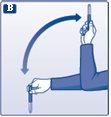
Always check that at least 12 units of insulin are left in the cartridge to allow for resuspension. If there are less than 12 units left, use a new FlexPen. The 12 units are marked on the residual scale. See the large image at the top of this instruction.
Do not use the pen if the resuspendedinsulin does not have a uniformly white and cloudyappearance.
Attaching the Needle
C
Remove the paper tab from a new disposable needle.
Screw the needle straight and firmly onto your FlexPen.

D
Remove the large outer needle cap and save it for later.

E
Remove the inner needle cap and discard it.
Never attempt to put the inner needle cap back on. You may stick yourself with the needle.

Always use a new needle for each injection. This reduces the risk of contamination, infection, insulin loss, needle blockage, and inaccurate dosing.
Be careful not to bend or damage the needle before use.
Checking the Insulin Flow
F
Before Each Injection, Small Amounts of Air May Form in the Cartridge During Normal Use. To Avoid Injecting Air and Ensure Accurate Dosing:
Turn the dose selector until 2 units are selected.
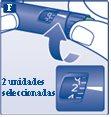
G
Hold your FlexPen with the needle pointing upwards and gently tap the cartridge with your finger several times to make any air bubbles rise to the top of the cartridge.

H
With the needle still pointing upwards, press the push-button fully. The dose selector returns to 0.
A drop of insulin should appear at the needle tip. If not, change the needle and repeat the procedure up to a maximum of 6 times.
If a drop of insulin still does not appear, the pen is defective and you must use a new one.
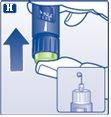
Always make sure a drop appears at the needle tip before injecting. This ensures that the insulin flows. If no drop appears, you will not inject any insulin, even if the dose selector moves. This could indicate that the needle is blocked or damaged.
Always check the flow before injecting. If you do not check the flow, you may receive too little or no insulin. This could result in high blood sugar levels.
Selecting the Dose
I
Check that the Dose Selector is Set to 0.
Turn the dose selector to select the number of units you need to inject.
The dose can be corrected either upwards or downwards by turning the dose selector in either direction until the correct dose is aligned with the dose marker. Be careful not to press the push-button when turning the dose selector, as insulin may be released.
You cannot select a dose greater than the number of units remaining in the cartridge.
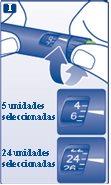
Before injecting, always use the dose selector and dose marker to see how many units you have selected.
Do not count the clicks of the pen. If you select a wrong dose and inject it, your blood sugar level may become too high or too low. Do not use the residual insulin scale, as it only shows the approximate amount of insulin remaining in the pen.
Injection
J
Insert the Needle Under the Skin. Use the Injection Technique Recommended by Your Doctor or Nurse.
Inject the dose by pressing the push-button fully until the 0 aligns with the dose marker. Be careful only to press the push-button when injecting.
Turning the dose selector does not inject insulin.
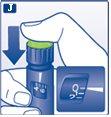
K
Keep the push-button fully pressed and keep the needle under the skin for at least 6 seconds. This will ensure that the full dose is injected.
Remove the needle from the skin and release the push-button.
Always make sure the dose selector returns to 0 after the injection. If the dose selector stops before reaching 0, the full dose has not been delivered, which may result in high blood sugar levels.

L
Cover the needle with the large outer cap without touching it. When the needle is covered, carefully press the large outer cap fully and then unscrew the needle.
Dispose of it carefully and put the pen cap back on.

Always remove the needle after each injection and store your FlexPen without the needle attached. This reduces the risk of contamination, infection, insulin loss, needle blockage, and inaccurate dosing.
Other Important Information
People who care for these patients must be careful when handling used needles to reduce the risk of accidental needlestick injury and infection.
Dispose of your used FlexPen carefully without leaving the needle on.
Never share the pen or needles with other people. This could lead to infection.
Never share the pen with other people. Your medicine may be harmful to their health.
Always keep the pen and needles out of the sight and reach of other people, especially children.

How much does INSULATARD FLEXPEN 100 IU/ml INJECTABLE SUSPENSION IN PRE-FILLED PEN cost in Spain ( 2025)?
The average price of INSULATARD FLEXPEN 100 IU/ml INJECTABLE SUSPENSION IN PRE-FILLED PEN in October, 2025 is around 38.03 EUR. Prices may vary depending on the region, pharmacy, and whether a prescription is required. Always check with a local pharmacy or online source for the most accurate information.
- Country of registration
- Average pharmacy price38.03 EUR
- Active substance
- Prescription requiredYes
- Manufacturer
- CompositionHIDROGENOFOSFATO DE SODIO DIHIDRATO (0 - mg), GLICEROL (E 422) (0 - mg), HIDROXIDO DE SODIO (E 524) (0 - mg)
- This information is for reference only and does not constitute medical advice. Always consult a licensed doctor before taking any medication. Oladoctor is not responsible for medical decisions based on this content.
- Alternatives to INSULATARD FLEXPEN 100 IU/ml INJECTABLE SUSPENSION IN PRE-FILLED PENDosage form: INJECTABLE, 100 IU/mlActive substance: insulin (human)Manufacturer: Lilly S.A.Prescription requiredDosage form: INJECTABLE, 100 IU/mlActive substance: insulin (human)Manufacturer: Lilly S.A.Prescription requiredDosage form: INJECTABLE, 100 IU/mlActive substance: insulin (human)Manufacturer: Novo Nordisk A/SPrescription required




